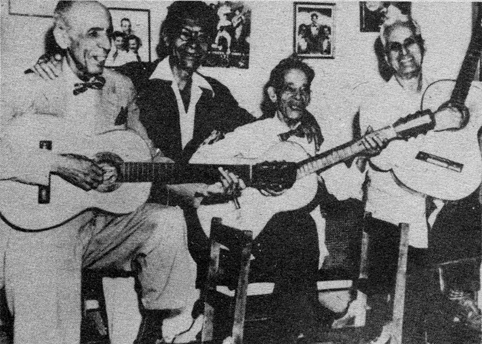
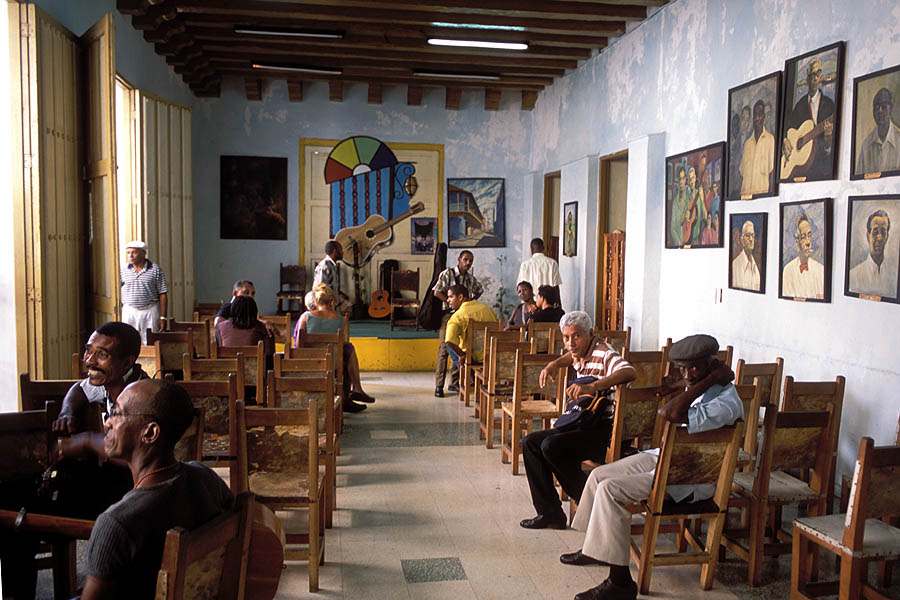
トロバ
Trova


The
four greats of the trova from left: Rosendo Ruiz, Manuel Corona, Sindo
Garay, Alberto Villalón/ Casa de la Trova, Santiago de Cuba
☆ トロバ[Trova] は、19世紀に生まれたキューバのポピュラー音楽のスタイルである。トロバは、キューバのオリエンテ州、特にサンティアゴ・デ・ クーバを旅し、歌とギターの演奏で生計を立てていたトロバドールと呼ばれる旅人音楽家たちによって創始された。 ヌエバ・トロバ・ミュージシャンのノエル・ニコラによれば、キューバのトロバドールはオリジナル曲や同時代のミュージシャンが書いた曲を歌い、ギターで伴 奏をつけ、詩的な感性を持った音楽を特徴とすることを目指した[2]。この定義は、ボレロスを歌うシンガーに最もよく当てはまり、ファンキーなソン(エ ル・グアヤベーロ)やグアガンコスやアバクア(チチョ・イバニェス)を歌うアフロキューバ人にはあまり当てはまらない。おそらく不公平なことに、ピアノ伴 奏をする歌手は除外されている。トロバの音楽家たちは、キューバのポピュラー音楽の発展において重要な役割を果たしてきた。集団として、彼らは作曲家とし て多作であり、より大きなグループでキャリアを積んだ多くの後進の音楽家に出発点を提供した。社会的にも、彼らはキューバのあらゆるコミュニティに浸透 し、キューバ音楽を世界中に広めることに貢献した[4]。
| Sindo Garay (born Antonio Gumersindo Garay García; Santiago de Cuba, 12
April 1867 – Havana, 17 July 1968) was a Cuban trova musician. He was
taught by Pepe Sánchez. Garay was one of the four greats of the trova.
He was of Spanish and Arawakan descent. Life & work Garay was the most outstanding composer of trova songs, and his best have been sung and recorded many times. Perla marina, Adios a La Habana, Mujer bayamesa, El huracan y la palma, Guarina and many others are now part of Cuba's heritage. Garay was also musically illiterate – in fact, he only taught himself the alphabet at 16 – but in his case not only were scores transcribed by others, but there are recordings as well. 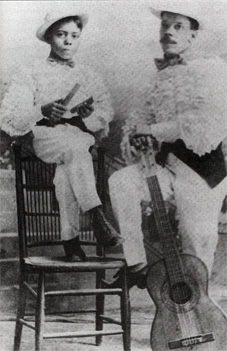 Guarionex and Sindo Garay, 1906 For a long period he sang in a duo with his eldest son Guarionex; he had two other sons and a daughter, and gave them all Indigenous names. In the 1890s Garay got involved in the Cuban War of Independence, and decided a stay in Hispaniola (Haiti and Dominican Republic) would be a good idea. It was, and he came back with a wife. Garay settled in Havana in 1906, and in 1926 joined Rita Montaner and others to visit Paris, spending three months there singing his songs. He broadcast on radio, made recordings and survived into modern times. He used to say "Not many men have shaken hands with both Jose Marti and Fidel Castro!" Carlos Puebla, whose life spanned the old and the new trova, told a good joke about him: "Sindo celebrated his 100th birthday several times – in fact, whenever he was short of money!"[1][2] References Sublette, Ned 2004. Cuba and its music: from the first drums to the mambo. Chicago. p. 298 de Leon, Carmela 1990. Sindo Garay: memorias de un trovador. La Habana. Garay's life story as told in his nineties; includes a 16-page appendix listing his compositions. |
シンド・ガライ(Antonio Gumersindo Garay
García、サンティアゴ・デ・クーバ、1867年4月12日 -
ハバナ、1968年7月17日)は、キューバのトロバ音楽家である。ペペ・サンチェスに師事した。ガライはトロバの四大巨頭の一人である。スペインとアラ
ワカの血を引く。 生涯と作品 ガライはトローバの歌の最も優れた作曲家であり、その代表作は何度も歌われ、録音されている。Perla marina、Adios a La Habana、Mujer bayamesa、El huracan y la palma、Guarina、その他多くの曲は、今やキューバの遺産の一部となっている。ガレイは音楽的な文盲でもあった-実際、彼は16歳の時にアル ファベットを独学で学んだだけだった-が、彼の場合、楽譜が他の人によって書き写されただけでなく、録音もある。  グアリオネックスとシンド・ガライ、1906年 長い間、彼は長男のグアリオネックスとデュオで歌っていたが、他に2人の息子と1人の娘がおり、全員に先住民の名前をつけていた。 1890年代、ガレイはキューバ独立戦争に巻き込まれ、イスパニョーラ(ハイチとドミニカ共和国)に滞在することを決めた。そして妻を連れて帰国した。ガ レイは1906年にハバナに定住し、1926年にはリタ・モンタネールらとパリを訪れ、そこで3ヶ月間自分の歌を歌った。彼はラジオで放送し、レコーディ ングを行い、現代まで生き残った。彼はよく 「ホセ・マルティとフィデル・カストロの両方と握手した男はそうそういない!」と言っていた。旧トロバと新トロバにまたがる人生を送ったカルロス・プエブ ラは、彼についていいジョークを言った: 「シンドは何度も100歳の誕生日を祝った。実際、金がないときはいつでもだ!」[1][2]。 参考文献 Sublette, Ned 2004. Cuba and its music: from the first drums to the mambo. Chicago. p. 298 de Leon, Carmela 1990. Sindo Garay: memorias de un trovador. La Habana. ラ・ハバナ。90歳を過ぎたガライの半生を綴る。 |
Rosendo Ruiz Suárez
(1 March 1885 – 1 January 1983) was a Cuban singer, guitarist and
composer, considered one of the founders of the trova. He wrote over
200 songs in a variety of styles ranging from canción and bolero to
guajira and bambuco. Although he was a popular performer, founding
several successful groups, he made very few recordings. He lived for
almost a century, having a great influence on the music of his
country.[1] Career Rosendo Ruiz Suárez was born in Santiago de Cuba on 1 March 1885. He became a tailor, but soon became interested in music. Like Sindo Garay, Ruiz had a humble background and he taught himself the guitar. Pepe Sánchez gave him lessons to improve his guitar technique and took him into a group of musicians who were brightening up fiestas for wealthy whites in the environs of Santiago de Cuba.[2] Short of money, he moved first to Cienfuegos, then to Havana. His first composition was "Venganza de amor", written in 1902. He later composed "Mares y arenas", with lyrics by Francisco Vélez Alvarado.[3] The song became a success in 1911 when it was premiered by José "Galleguito" Parapar at Havana's Teatro Martí in his first professional performance.[4] The first recording of a composition by Ruiz was Maria Teresa Vera's and Rafael Zequeira's 1914 rendition of "Tere y Gela". The duo would go on to record many of Ruiz's songs, sometimes accompanied by Manuel Corona on guitar: "Rosina y Virginia" (also known as "Dos lindas rosas"), "Confesión", "Naturaleza", "Encanto de Estela", "Patria y honor", "Violeta", "Mi Cuba bella", "Llanto del corazón" and "Cuba aliada". In 1917 he composed his socialist anthem, "Redención", which premiered on 1 May 1919 (International Workers' Day) at the Teatro Payret in Havana. In 1918, José Castillo and Manuel Luna recorded one of his most famous songs, "Falso juramento". In 1926 he founded the Cuarteto Cuba with Vitaliano Matas (lead guitar), Eusebio Corzo (vocals) and Rafael Ruiz (lead vocals).[5] In 1929 he founded the Trío Habana with Emilio Betancourt and Enrique Hernández, making several recordings for Brunswick Records the same year.[5] In 1929 he was bestowed an honorary award at Seville's Ibero-American Exposition. In 1932, the Cuarteto Machín recorded in New York City his famous guajira "Junto a un cañaveral", and Julio Cueva's orchestra recorded his pregón "Se va el dulcerito" in Paris.[6] In 1936 he formed the Trío Azul in Havana with Guillermo Rodríguez Fiffe and Enrique Valls, who came as a duo from Santiago.[7] They had a hit with "Bilongo" (also known as "La negra Tomasa"), a composition by Rodríguez Fiffe. In 1937 they recorded a single for Victor: "La comparsa Malaco" / "Solavaya".[7] He wrote a guitar manual which ran into several editions, and was a president of the Forum de la Trova (1967). His son, Rosendo Ruiz Quevedo, known as Rosendo Ruiz Jr., also became a musician and one of Cuba's most prolific composers. Ruiz died on 1 January 1983 in Havana, Cuba aged 97.[8] https://en.wikipedia.org/wiki/Rosendo_Ruiz |
ロ
センド・ルイス・スアレス(1885年3月1日-1983年1月1日)は、キューバの歌手、ギタリスト、作曲家で、トローバの創始者の一人とされている。
カンシオン、ボレロからグアヒーラ、バンブーコまで様々なスタイルの曲を200曲以上作曲した。演奏家としても人気があり、いくつかのグループを結成して
成功を収めたが、レコーディングはほとんど行われなかった。1世紀近く生き、母国の音楽に大きな影響を与えた[1]。 経歴 ロセンド・ルイス・スアレスは1885年3月1日にサンティアゴ・デ・クーバで生まれた。仕立て屋になったが、すぐに音楽に興味を持つようになった。シン ド・ガライと同様、ルイズも質素な生い立ちで、独学でギターを学んだ。ペペ・サンチェスは、ギターのテクニックを向上させるために彼にレッスンを与え、サ ンティアゴ・デ・クーバ近郊の裕福な白人たちの祝祭を盛り上げていた音楽家のグループに彼を引き入れた。彼の最初の作曲は1902年に書かれた 「Venganza de amor 」であった。その後、フランシスコ・ベレス・アルバラードが作詞した 「Mares y arenas 」を作曲した[3]。この曲は1911年、ホセ・「Galleguito」・パラパルがハバナのマルティ劇場でプロとして初めて初演し、成功を収めた [4]。 ルイスの作曲による最初のレコーディングは、マリア・テレサ・ベラとラファエル・ゼケイラによる1914年の「Tere y Gela」であった。このデュオはその後、マヌエル・コロナのギター伴奏でルイズの曲を数多く録音することになる: 「ロジーナとヴァージニア「(」Dos lindas rosas 「としても知られる)、」Confesión「、」Naturaleza「、」Encanto de Estela「、」Patria y honor「、」Violeta「、」Mi Cuba bella「、」Llanto del corazón「、」Cuba aliada "などである。1917年には社会主義歌曲「レデンシオン」を作曲し、1919年5月1日(国際労働者デー)にハバナのテアトロ・パイレで初演された。 1918年、ホセ・カスティーヨとマヌエル・ルナが、彼の最も有名な曲のひとつである 「Falso juramento 」を録音した。1926年、ビタリアーノ・マタス(リード・ギター)、エウセビオ・コルソ(ヴォーカル)、ラファエル・ルイス(リード・ヴォーカル)と共 にクアルテート・クーバを結成[5] 1929年、エミリオ・ベタンコート、エンリケ・エルナンデスとトリオ・ハバナを結成し、同年にブランズウィック・レコードで数枚のレコーディングを行っ た[5] 1929年、セビリアのイベロアメリカ博覧会で名誉賞を授与される。 1932年には、クアルテート・マチンがニューヨークで彼の有名なグアヒーラ「Junto a un cañaveral」を録音し、フリオ・クエバのオーケストラがパリで彼のプレゴン「Se va el dulcerito」を録音した[6]。 [6] 1936年には、サンティアゴからデュオでやってきたギジェルモ・ロドリゲス・フィフ、エンリケ・バルスとハバナでトリオ・アズールを結成した[7]。ロ ドリゲス・フィフ作曲の「ビロンゴ」(別名「ラ・ネグラ・トマサ」)がヒットした。1937年、彼らはビクターにシングルを録音した: 「La comparsa Malaco「/」Solavaya "である[7]。 また、ギター・マニュアルを執筆し、何度も版を重ねた。息子のロセンド・ルイス・ケベド(ロセンド・ルイス・ジュニア)も音楽家となり、キューバで最も多作な作曲家の一人となった。ルイズは1983年1月1日、キューバのハバナで97歳で死去した[8]。 |
Alberto
Villalón Morales (7 June 1882 in Santiago de Cuba – 16 July 1955 in
Havana) was one of the greatest musicians in the Cuban trova style.[1]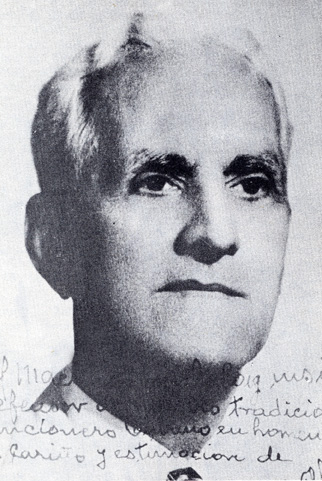 Alberto Villalón He was the only one of the 'four greats' of the trova to come from a well-to-do family. Villalón and his sister América studied guitar with Pepe Sánchez, the father of the trova movement. Later, he studied classical guitar to achieve a really excellent technique.[2] He composed his first canciones and boleros at fourteen, and moved to Havana in 1900. In 1907 he recorded on Edison cylinders. In 1908 he formed the Cuarteto Villalón with Adolfo Colombo (tenor), Claudio García (baritone), Emilio Reinoso (mandolin), and Alberto Villalón (guitar). Colombo and García were regular members of the Teatro Alhambra company; Colombo was the most recorded singer of the age.[3] A difference between Villalón and the other early trovadors was in his guitar technique. With his training he preferred picking (punteado) instead of strumming (rasgueado), which had been the main technique previously. This gave him a wider range of harmonic possibilities and a characteristic style. He had a second career in 1927 when he became a founding member of the Septeto Nacional de Ignacio Piñeiro. Alberto brought into the septet Juan de la Cruz and Benvenido León, who had been playing with him in a trio. The addition of the first really great sonero, Abelardo Barroso (1905 – 1972), made the Nacional the best group in Cuba for its time. Villalón's career, then, connected the world of trova with the world of son which became central to Cuba's popular music for the rest of the century. |
アルベルト・ビジャロン・モラレス(1882年6月7日サンティアゴ・デ・クーバ - 1955年7月16日ハバナ)は、キューバのトロバ様式における最も偉大な音楽家の一人である[1]。 アルベルト・ビジャロン 彼はトロバの「四大巨頭」の中で唯一、裕福な家庭の出身であった。ビジャロンと妹のアメリカは、トロバ運動の父ペペ・サンチェスにギターを師事した。その 後、クラシック・ギターを学び、実に優れたテクニックを身につけた[2]。14歳で最初のカンシオンとボレロを作曲し、1900年にハバナに移り住んだ。 1907年にはエジソンのシリンダーで録音を行う。1908年、アドルフォ・コロンボ(テノール)、クラウディオ・ガルシア(バリトン)、エミリオ・レイ ノーソ(マンドリン)、アルベルト・ビジャロン(ギター)とクアルテート・ビジャロンを結成。コロンボとガルシアはアルハンブラ劇場の常連メンバーであ り、コロンボは当時最もレコーディングされた歌手であった[3]。 ビジャロンと他の初期のトロヴァドールたちとの違いは、ギターのテクニックにあった。それまでの主な奏法であった打ち込み(ラスゲアード)ではなく、ピッ キング(プンテアード)を好んだ。これにより、彼はより幅広いハーモニーの可能性と特徴的なスタイルを手に入れた。1927年、イグナシオ・ピニェイロ・ セプテート・ナシオナルの創設メンバーとなり、第二のキャリアをスタートさせた。アルベルトは、それまでトリオで一緒に演奏していたフアン・デ・ラ・クル スとベンベニド・レオンをセプテットに加えた。最初の偉大なソネーロ、アベラルド・バロソ(1905~1972)が加わったことで、ナシオナルは当時 キューバ最高のグループとなった。 ビジャロンのキャリアは、トロバの世界と、その後の世紀のキューバのポピュラー音楽の中心となったソノの世界を結びつけることになった。 |
Manuel
Corona Raimundo (17 June 1880, in Caibarién – 9 January 1950 in
Marianao, Havana) was a Cuban trova musician, and a long-term
professional rival of Sindo Garay.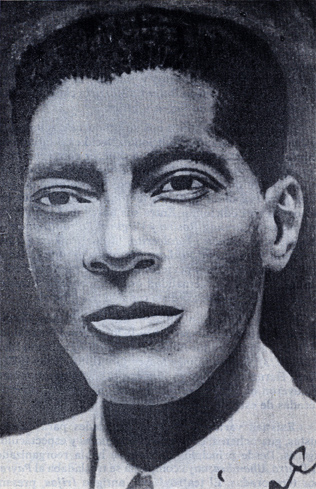 Manuel Corona one of the four greats of the trova [1] He came to Havana when the Cuban War of Independence broke out, and worked as a bootblack and a cigar-roller. His supervisor at the cigar factory taught him the guitar, and in 1905 he set up in a café in the red-light district of San Isidro. The district was controlled by the chulo (pimp) Alberto Yarini (1882–1910), who became famous for introducing French prostitutes (putas francesas) willing to perform more salacious acts than even the Cubans were used to.[2] The francesas cut heavily into the profits of the Cuban putas, and the result was a gang war in which Yarini was killed. Corona was present through all this, playing and singing to the punters, whores and pimps. He and one of the girls developed a love affair, and soon enough her pimp was on his trail. In a line that might have come from "Frankie and Johnny", Corona said later "She was a whore, and she had her man, but I liked her." The pimp came after him with a knife, and a cut to his hand prevented him playing the guitar again. From then on he lived from his compositions.[3] He wrote hundreds of compositions, some of them amongst the finest examples of Cuban sentiment, such as Mercedes, Longina, Santa Cecilia and Aurora. Guarachas such as El servicio obligatorio (National Service) and Acelera, Ñico, acelera were topical comments. La habanera was a deliberate reply to Garay's La bayamesa. Corona died in poverty.[4] https://en.wikipedia.org/wiki/Manuel_Corona_(musician) |
マヌエル・コロナ・ライムンド(1880年6月17日、カイバレン生ま
れ - 1950年1月9日、ハバナ、マリアナオ出身)は、キューバのトロバ音楽家で、シンド・ガライの長年のライバルだった。 マヌエル・コロナ トロバの四大巨頭の一人[1]。 キューバ独立戦争勃発と同時にハバナに渡り、靴磨きと葉巻職人として働いた。葉巻工場の上司からギターを教わり、1905年にサン・イシドロの歓楽街のカ フェに入った。この地区はチュロ(ポン引き)のアルベルト・ヤリーニ(1882年-1910年)が支配していたが、彼はキューバ人でさえ慣れていないよう な淫らな行為をしてくれるフランス人娼婦(プータ・フランセーサ)を連れてきたことで有名になった[2]。フランセーサはキューバ人プータたちの利益を大 きく削り、その結果、ヤリーニが殺されたギャングの抗争が起こった。 コローナはそのすべてに立ち会い、客、売春婦、ポン引きたちに演奏し、歌った。コロナと一人の女は恋に落ち、やがて彼女のポン引きがコロナを追うように なった。『フランキーとジョニー』に出てきそうなセリフだが、コロナは後にこう語っている。ポン引きはナイフを持って彼を追いかけ、手に切り傷を負った彼 は二度とギターを弾けなくなった。それ以来、彼は作曲で生活するようになった[3]。 彼は何百もの曲を書いたが、そのうちのいくつかは、メルセデス、ロンギナ、サンタ・セシリア、オーロラなど、キューバ情緒の最高傑作に数えられている。 El servicio obligatorio(国民服務義務)やAcelera, Ñico, aceleraなどのグアラチャは、時事的なコメントだった。La habanera(ラ・ハバネラ)は、ガライのLa bayamesa(ラ・バヤメサ)に対する意図的な返答であった。コローナは貧困の中で亡くなった[4]。 |
| Patricio Ballagas Palacio
(Camagüey, 17 March 1879 – Havana, 15 February 1920) was a Cuban
composer and guitarist, considered an important innovator in trova
music.[1] His compositions were written in 4 4 time when most others were composing in 2 4 time; and more important, he invented 'double text', where the melody is superimposed over the lead vocal, which then becomes the second voice. He introduced contracanto into the trova form, so that the second voice changes from being intimately connected to the first voice to becoming a melodic and harmonic expression with its own identity.[2] 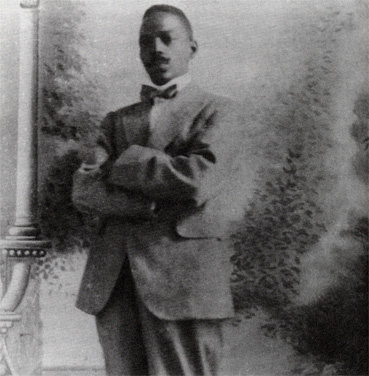 The historian of trova, Dulcilla Cañizares, asks the question "Por qué no, Patricio Ballagas?[3] She thinks he should rank as one of the top five of trova. His short life probably militated against greater recognition of his talent. "Timidez", written in 1914, is his most famous number.[1] As a musician, Ballagas was a member of the Cuarteto Nano and formed a duo with Alejandro Montalván.[1] Orovio, Helio (2004). Cuban Music from A to Z. Bath, UK: Tumi. p. 23. ISBN 9780822385219. Further discussion of such developments can be found in: León, Argeliers 1984. Del canto y el tiempo. La Habana. Cañizares, Dulcila 1995. La trova tradicional. 2nd ed, La Habana. p. 64 https://en.wikipedia.org/wiki/Patricio_Ballagas |
パトリシオ・バラガス・パラシオ(Patricio Ballagas Palacio, Camagüey, 1879年3月17日 - ハバナ, 1920年2月15日)はキューバの作曲家、ギタリストで、トロバ音楽の重要な革新者と考えられている[1]。 4拍子で作曲された。 さらに重要なのは、メロディをリード・ヴォーカルに重ね合わせ、それが第二声となる「ダブル・テキスト」を考案したことである。彼はトロヴァの形式にコン トラカントを導入し、第2声が第1声と密接に結びついた状態から、独自のアイデンティティを持つ旋律的・和声的表現へと変化するようにした[2]。  トロヴァの歴史家であるドゥルシージャ・カニサレスは、「パトリシオ・バラガスがいないのはなぜか」と問いかけている[3]。 彼女は、彼がトロヴァのトップ5にランクされるべきだと考えている。彼の短命は、おそらく彼の才能がより広く認められることを妨げたのだろう。1914年 に書かれた 「Timidez 」は、彼の最も有名なナンバーである[1]。ミュージシャンとして、バラガスはクアルテート・ナノのメンバーであり、アレハンドロ・モンタルバンとデュオ を組んでいた[1]。 |
| Eusebio Delfín y Figueroa
(1 April 1893 in Palmira – 28 April 1965 in Havana) was a Cuban banker
and musician, recognized for the introduction of arpeggio to Cuban
popular music, as well as for his numerous compositions, interpreted by
the Buena Vista Social Club, Celia Cruz, Omara Portuondo, and others. Biography Nicknamed "The Aristocrat Trobadour", Eusebio Delfín was born in Palmira to a Spanish-Italian aristocratic family. His father, Ramón Delfín, was the Spanish corregidor for trade in Cienfuegos (by Royal Decree of 1898), and the consular representative for the Kingdom of Italy. His brother Ramón María Delfín wrote the novel "La Gloria de la Familia" ("The Glory of the Family"). In Cienfuegos, Eusebio was trained as an accountant, hoping he could build a career in finance. He eventually became the director of the Banco Comercial, and married Amalia Bacardi y Cape, daughter of rum-magnate Emilio Bacardí, senator and mayor of Santiago de Cuba. Their only child, Eusebio Delfín y Bacardí, was the president of Compañía Cubana de Aviación until the Cuban Revolution. Musical legacy Delfín studied violin and flute, but soon switched to guitar and song. His guitar teacher was Fernando Barrios, and his singing coach was Vincente Sánchez Torralba.[1] He also studied guitar and song, and sang in public for the first time in 1916 at a charitable venue held at the Terry Theatre in Cienfuegos.[2] Beginning in 1921, he recorded many Cuban songs, both solo and in duets with partners such as Rita Montaner. The first 78rpm with Montaner was Pensamiento (by Rafael Gómez, 'Teofilito'). In 1922 he organised, with Eduardo Sánchez de Fuentes, concerts of typical Cuban music in Havana and Cienfuegos. A relatively wealthy man, Delfín donated much of his royalties to charity in Cienfuegos.[3] According to Guyún, Delfin was responsible for changing the style used to accompany boleros. In the 1920s, boleros were often accompanied by guitar in rayado or rasgueado manner (~strumming); Delfin changed that to a semi-arpeggio style (~picking). He also repeated the rhythm by time and a half, leaving the weak part of the second beat silent. His style became widely popular. His compositions include poetry put to music, such as La Guinda, from a poem by Pedro Mata, and he also wrote his own lyrics, such as ¿Y Tú Qué Has Hecho? (aka En El Tronco De Un Árbol.), Ansia and Qué Boca La Tuya [4] At the soirées of the rich he sang boleros, with the result that the wealthy young became enthusiastic about the guitar.[5] His best-known classic, ¿Y Tú Qué Has Hecho? appeared in the 1997 Buena Vista Social Club debut album, considered one of the most important musical albums of all time, according to Rolling Stone Magazine. According to her own account, the same song was being sung by Celia Cruz when discovered. https://en.wikipedia.org/wiki/Eusebio_Delf%C3%ADn |
エウセビオ・デルフィン・イ・フィゲロア(1893年4月1日パルミラ - 1965年4月28日ハバナ)はキューバの銀行家、音楽家で、キューバのポピュラー音楽にアルペジオを導入したことで知られる。 バイオグラフィー トロバドゥール貴族」のニックネームを持つエウセビオ・デルフィンは、パルミラのスペイン系イタリア人貴族の家に生まれた。父のラモン・デルフィンは、 1898年の勅令でシエンフエゴスのスペイン通商代表(コレギドール)を務め、イタリア王国の領事代理も務めた。兄のラモン・マリア・デルフィンは小説 「La Gloria de la Familia」(「家族の栄光」)を書いた。シエンフエゴスでエウセビオは会計士としての訓練を受け、金融業界でのキャリアを築くことを望んだ。やがて バンコ・コメルシアルのディレクターとなり、ラム酒王エミリオ・バカルディ(上院議員、サンティアゴ・デ・クーバ市長)の娘アマリア・バカルディ・イ・ ケープと結婚した。二人の間に生まれた一人息子のエウセビオ・デルフィン・イ・バカルディは、キューバ革命が起こるまでキューバ航空会社の社長を務めた。 音楽の遺産 デルフィンはヴァイオリンとフルートを学んだが、すぐにギターと歌に転向した。ギターの師匠はフェルナンド・バリオス、歌のコーチはヴィンセンテ・サン チェス・トラルバだった[1]。また、ギターと歌を学び、1916年にシエンフエゴスのテリー劇場で開催された慈善の場で初めて人前で歌った[2]。 1921年からは、ソロやリタ・モンタネールらとのデュエットで多くのキューバン・ソングを録音した。モンタネルとの最初の78回転盤は 「Pensamiento」(ラファエル・ゴメス作、「Teofilito」)であった。1922年には、エドゥアルド・サンチェス・デ・フエンテスとと もに、ハバナとシエンフエゴスで典型的なキューバ音楽のコンサートを開催した。比較的裕福だったデルフィンは、印税の多くをシエンフエゴスの慈善団体に寄 付した[3]。 グユンによると、デルフィンはボレロの伴奏に使われるスタイルを変えた張本人である。1920年代、ボレロの伴奏はラヤドやラスゲアードのギターが多かっ たが、デルフィンはそれをセミ・アルペジオ(ピッキング)のスタイルに変えた。彼はまた、2拍目の弱い部分を無音にして、1拍半ずつリズムを繰り返した。 彼のスタイルは広く人気を博した。彼の作曲には、ペドロ・マタの詩を音楽化した「ラ・グィンダ」のような詩の曲もあり、「¿Y Tú Qué Has Hecho? (aka En El Tronco De Un Árbol.)』、『Ansia』、『Qué Boca La Tuya』などがある[4]。 富裕層のソワレで彼はボレロを歌い、その結果、裕福な若者たちはギターに熱中するようになった[5]。 ローリング・ストーン誌によると、彼の最も有名な名曲『¿Y Tú Qué Has Hecho?"』は、1997年のブエナ・ビスタ・ソシアル・クラブのデビュー・アルバムに収録されており、史上最も重要な音楽アルバムのひとつとされて いる。彼女自身の証言によると、発見されたとき、同じ曲をセリア・クルスが歌っていたという。 |
María
Teresa Vera (February 6, 1895 in Guanajay – December 17, 1965 in
Havana) was a Cuban singer, guitarist and composer. She was an
outstanding example of the Cuban trova movement.[1]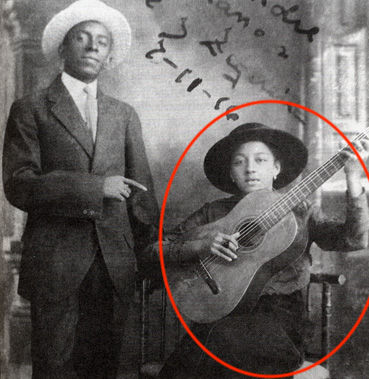 Career She started her career as a singer in 1911 in a theater where she sang the criolla Mercedes of Manuel Corona. Her first guitar teacher was the cigar-roller José Díaz. Manuel Corona continued her musical education by explaining such things as the different methods for first and second guitar, and eventually taught her his compositions. She formed a duo with Rafael Zequeira from 1916 until 1924 when he fell ill and died. They made over a hundred recordings together in New York, most of which have not survived. Then she met Carlos Godinez, a composer, who taught her more about the guitar; the friendship lasted until his death in 1950. She then formed the Sexteto Occidente in 1925 with Miguel García as first voice, clavé and Director (because he knew most about music), Ignacio Piñeiro on double bass, Julio Torres Biart on tres, Manuel Reinoso on bongo and Francisco Sánchez on maracas. They were a group of talented musicians who would have sparkling careers.[2] She joined Lorenzo Hierrezuelo as a duo in 1935, and this duo lasted for 27 years. For much of this time Hierrezuelo ran his duo with Vera alongside his partnership with Company Segundo (Francisco Repilado), as the duo Los Compadres. One of her best compositions, the habanera Veinte años,[3] has been performed by a number of Cuban artists; Sólo pienso en ti, a bolero–son, is also well-known. In 1945 she was contracted to Circuito CMQ for the radio program Cosas de Ayer. In the 1950s, she appeared in the TV program El Casino de la Alegría and in the 1960s she received public tributes on her retirement in 1962. Opinions of her In his biography Jorge Calderón gives the opinions of 32 Cuban composers and musicians on her career. Silvio Rodríguez said of her: "Her voice was without vibrato, dry; hitting the notes, only prolonging a note so as to slide from one tone to another, which gave [her voice] a grace, or, much better, a singular character . Her production seemed nonchalant, natural, colloquial... Always there were variations on the original melody, [since] she was always interpreting [the piece] creatively." Pablo Milanés contented himself with saying "María Teresa is for me the embodiment of Cuban song."[4] María Teresa Linares, the musicologist, said of her and Hierrezuelo: "I believe the most important period [for them] was their 27 years as a duet, Lorenzo on first guitar, Vera on second. Hierrezuelo's voice was at its best... [and] María Teresa's voice was unrivaled at the time. The quality of their appoggiaturas, adornments, refinements, and their interpretation... reached its highest point. All in all, it was the most sublime expression of the Cuban song."[5] Sexteto Occidente, New York 1926 back: María Teresa Vera (guitar), Ignacio Piñeiro (double bass), Julio Torres Biart (tres); front: Miguelito Garcia (clavé), Manuel Reinoso (bongó) and Francisco Sánchez (maracas) Tribute On February 6, 2020, Google celebrated her 125th birthday with a Google Doodle.[6] References Calderon, Jorge 1983. Maria Teresa Vera. La Habana. Tumbao TCD-087 Sexteto Occidente: Yo no tumbo caña liner notes a bolero–son in the arrangement by Antonio María Romeu Calderon, Jorge 1983. Maria Teresa Vera. Opinions on pages 110–143; Rodrigues on p137. La Habana. Ma. Teresa Linares in liner notes to CD NubeNegra INT 3193 2 A María Teresa Vera. "María Teresa Vera's 125th Birthday". Google. February 6, 2020. https://en.wikipedia.org/wiki/Mar%C3%ADa_Teresa_Vera |
マリア・テレサ・ベラ(María Teresa Vera、1895年2月6日グアナハイ生まれ - 1965年12月17日ハバナ生まれ)は、キューバの歌手、ギタリスト、作曲家である。彼女はキューバのトロバ運動の傑出した例であった[1]。 経歴 1911年、劇場でマヌエル・コロナのクリオラ・メルセデスを歌い、歌手としてのキャリアをスタートさせた。彼女の最初のギターの師匠は、葉巻職人のホ セ・ディアスだった。マヌエル・コロナは、ファースト・ギターとセカンド・ギターの奏法の違いなどを説明しながら彼女の音楽教育を続け、やがて彼の作曲し た曲を教えた。 1916年からラファエル・ゼケイラとデュオを組み、彼が病気で亡くなる1924年まで活動した。彼らはニューヨークで100以上のレコーディングを行 なったが、そのほとんどは現存していない。その後、彼女は作曲家のカルロス・ゴディネスと出会い、彼からギターについて多くのことを教わった。 その後、彼女は1925年にセクステート・オクシデンテを結成し、第一声、クラベ、ディレクターにミゲル・ガルシア(彼が最も音楽に精通していたため)、 コントラバスにイグナシオ・ピニェイロ、トレスにフリオ・トーレス・ビアルト、ボンゴにマヌエル・レイノソ、マラカスにフランシスコ・サンチェスを迎え た。彼らは、輝かしいキャリアを持つことになる才能あるミュージシャンたちだった[2]。 彼女は1935年にロレンソ・ヒエレスエロとデュオを組み、このデュオは27年間続いた。ヒエレスエロは、カンパニー・セグンド(フランシスコ・レピラード)とのデュオと並行して、ロス・コンパドレスというデュオを組んでいた。 彼女の代表曲のひとつであるハバネラ「Veinte años」[3]は、多くのキューバ人アーティストによって演奏されており、ボレロ・ソン「Sólo pienso en ti」もよく知られている。1945年、彼女はラジオ番組『Cosas de Ayer』のためにCircuito CMQと契約した。1950年代にはテレビ番組『エル・カジノ・デ・ラ・アレグリア』に出演し、1960年代には、1962年に引退する際に多くの賛辞を 受けた。 彼女に対する意見 ホルヘ・カルデロンはその伝記の中で、彼女のキャリアについて32人のキューバの作曲家や音楽家の意見を紹介している。シルビオ・ロドリゲスは彼女についてこう語っている: 「彼女の声にはビブラートがなく、乾いていた。音符を叩きながら、ある音から別の音へと滑るように音符を延ばすだけで、(彼女の声に)優雅さ、いや、もっ といいことに、特異な特徴を与えていた。彼女の演奏は、淡々としていて、自然で、口語的で......。彼女は常に創造的な解釈をしていたため、オリジナ ルのメロディには常にバリエーションがあった」。 パブロ・ミラネスは、「マリア・テレサは私にとってキューバ歌曲の体現者である」[4]と言って満足している。 音楽学者のマリア・テレサ・リナレスは、彼女とヒエレスエロについてこう語っている: 「彼らにとって)最も重要な時期は、ロレンソがファースト・ギター、ヴェラがセカンド・ギターを担当した27年間のデュエットだったと思う。ヒエレスエロ の声は最高の状態だった。[マリア・テレサの声は当時、他の追随を許さなかった。彼らのアポジャトゥーラ、装飾、洗練、解釈の質は...最高点に達してい た。全体として、キューバの歌の最も崇高な表現だった」[5]。 セクステート・オクシデンテ、ニューヨーク 1926年 バック マリア・テレサ・ヴェラ(ギター)、イグナシオ・ピニェイロ(コントラバス)、フリオ・トーレス・ビアルト(トレス)、手前: ミゲリート・ガルシア(クラベ)、マヌエル・レイノソ(ボンゴ)、フランシスコ・サンチェス(マラカス) トリビュート 2020年2月6日、Googleは彼女の125歳の誕生日をGoogle Doodleで祝った[6]。 参考文献 Calderon, Jorge 1983. Maria Teresa Vera. ラ・ハバナ。 Tumbao TCD-087 Sexteto Occidente: ヨ・ノー・トゥンボ・カーニャ」ライナーノーツ アントニオ・マリア・ロメウ編曲によるボレロ・ソング カルデロン、ホルヘ1983 マリア・テレサ・ヴェラ 110-143ページに意見、137ページにロドリゲス。ラ・ハバナ。 Ma. Teresa LinaresがCD NubeNegra INT 3193 2 A María Teresa Veraのライナーノーツに書いている。 「マリア・テレサ・ベラの125回目の誕生日」. Google. 2020年2月6日。 |
| Lorenzo Hierrezuelo
(Hierrezuelo La O, 5 September 1907 in El Caney – 16 November 1993 in
Havana) was a Cuban trova musician, singer, guitarist and composer. His
face showed clear signs of Amerindian descent: he was of Indo-mulatto
heritage (one of his grandmothers was a Siboney). He was the son and
nephew of soneros, and he grew up in the ambiance of this type of Cuban
music and dance. At ten, he was singing in Santiago de Cuba; at
thirteen he formed a trio with two friends: the trio eventually left
for Havana. They sang in cafés and private houses.[1][2] He worked for most of his life in duos with three important Cuban trovadors. When his two friends returned to Oriente, Lorenzo met María Teresa Vera, and formed a duo with her in 1937. Later, with Compay Segundo (Francisco Repilado), he formed the duo Los Compadres; lastly he continued under the same title with his brother, Reinaldo Hierrezuelo, known as Rey Caney. He also had a sister, Caridad Hierrezuelo, who was a singer in the guaracha style. Los Compadres became a successful touring act, singing in most countries of the Americas. Lorenzo and his brother remained based in Cuba for the rest of their lives. Reinaldo became a member of the Vieja Trova Santiaguera. Lorenzo composed a large number of sones, boleros and guarachas, such as Barbarita tiene novio, Cantando mi son yo me muero, Caña quema, Culpable no soy, El hule de Tomasita, Ese palo tiene jutía, Mal tiempo, Mi son oriental, Rita la caimana, and Sarandonga. References Linares, María Teresa 1981. La música y el pueblo. La Habana, Cuba. p102 Orovio, Helio 2004. Cuban music from A to Z. Duke University, Durham NC; Tumi, Bath. p111 https://en.wikipedia.org/wiki/Lorenzo_Hierrezuelo |
ロレンソ・ヒエレスエロ(Hierrezuelo La
O、1907年9月5日エル・カネイ -
1993年11月16日ハバナ)は、キューバのトロバ音楽家、歌手、ギタリスト、作曲家である。彼の顔は明らかにアメリカインディアンの血を引いている。
彼はソネーロたち?の息子と甥であり、キューバ音楽とダンスの雰囲気の中で育った。10歳の時にはサンティアゴ・デ・クーバで歌い、13歳の時には2人の
友人とトリオを結成した。彼らはカフェや民家で歌っていた[1][2]。 彼は生涯のほとんどを3人の重要なキューバのトロヴァドールとデュオで活動した。2人の友人がオリエンテに戻ったとき、ロレンソはマリア・テレサ・ベラと 出会い、1937年に彼女とデュオを組む。その後、コンパイ・セグンド(フランシスコ・レピラード)とデュオ「ロス・コンパドレス」を結成し、最後にレ イ・カネイとして知られる弟のレイナルド・ヒエレスエロと同じタイトルでデュオを続けた。彼にはまた、グアラチャ・スタイルの歌手であったカリダッド・ヒ エレスエロという妹がいた。ロス・コンパドレスはツアーで成功を収め、アメリカ大陸のほとんどの国で歌った。ロレンソと弟は、生涯キューバを拠点に活動し た。レイナルドはビエハ・トロバ・サンティアゲーラのメンバーとなった。 ロレンソは、Barbarita tiene novio、Cantando mi son yo me muero、Caña quema、Culpable no soy、El hule de Tomasita、Ese palo tiene jutía、Mal tiempo、Mi son oriental、Rita la caimana、Sarandongaなど、数多くのソネ、ボレロ、ガラチャを作曲した。 参考文献 Linares, María Teresa 1981. La música y el pueblo. La Habana, Cuba. p102 Orovio, Helio 2004. Duke University, Durham NC; Tumi, Bath. p111. |
Máximo Francisco Repilado Muñoz Telles (18 November 1907 – 13 July 2003), known professionally as "Compay Segundo", was a Cuban trova guitarist, singer and composer.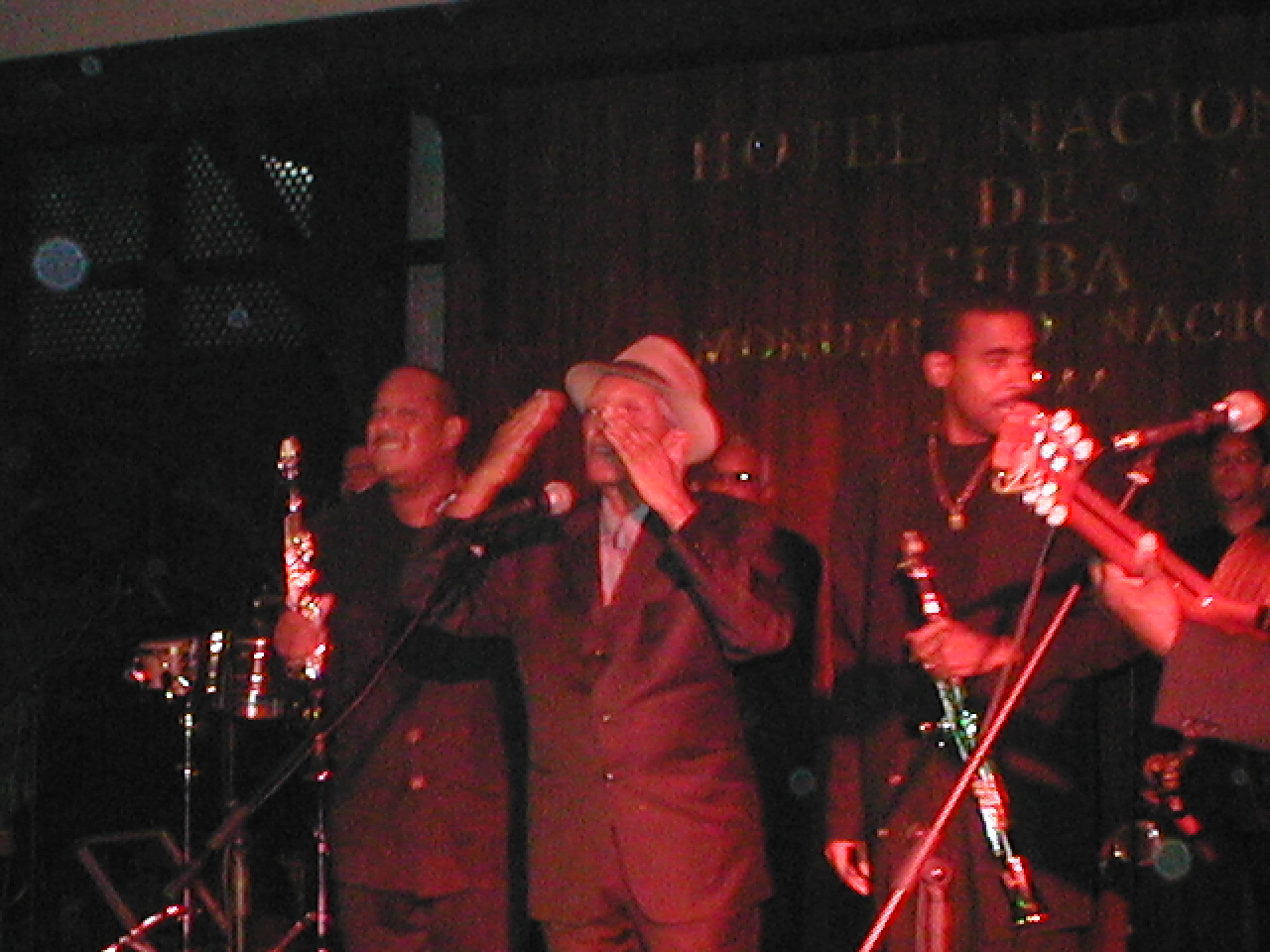 Biography Compay (meaning compadre) Segundo, so called because he was always second voice in his musical partnerships, was born in Siboney, Cuba, and moved to Santiago de Cuba at the age of nine. His first engagement was in the Municipal Band of Santiago de Cuba, directed by his teacher, Enrique Bueno. In 1934, after a spell in a quintet, he moved to Havana, where he also played the clarinet in CI the Municipal Band. He also learned to play the guitar and the tres, which became his usual instruments. Compay Segundo also invented the armónico, a seven-stringed guitar-like instrument, to fill the harmonic jump between the Spanish guitar and the tres.[1] In the 1950s he became well known as the second voice and tres player in Los Compadres, a duo he formed with Lorenzo Hierrezuelo in 1947.[2] Los Compadres were one of the most successful Cuban duos of their time. Greater international fame came later, in 1997, with the release of the Buena Vista Social Club album, a hugely successful recording which won several Grammy awards. Compay Segundo appeared in the Wim Wenders film of the same title.[1] Segundo's most famous composition is "Chan Chan", the opening track on the Buena Vista Social Club album, a four-chord son cubano song. "Chan Chan" was recorded by Segundo himself various times as well as by countless other Latin artists. Other compositions are "Sarandonga", "La calabaza", "Hey caramba", "Macusa", "Saludo Compay". These are all sones, and this differentiates siu him from the more usual trova musicians, with their devotion to the bolero. However, it seems his interests went much further: I have danzones, waltzes, sones. I have some beautiful danzones. Why? Because I've learned from those who know how to preserve the tradition of the music. I play music the way it was played in yesteryear. I started out playing the son corto (short son). As Miguel Matamoros used to say, "The son is short and sweet."... Back in the day, they'd start out playing son at seven in the evening, and they'd greet the dawn with it.[3] At a fiesta he sang to President Fidel Castro, who took his pulse and joked about his vitality despite his 90-plus years. "Who could have imagined that?" he asked when he found himself at the Vatican City, performing "Chan Chan" before Pope John Paul II. He explained his longevity simply: mutton consommé and a drink of rum. He predicted that he would live to be 115, but died of kidney failure in Havana, 20 years short of his ambition. 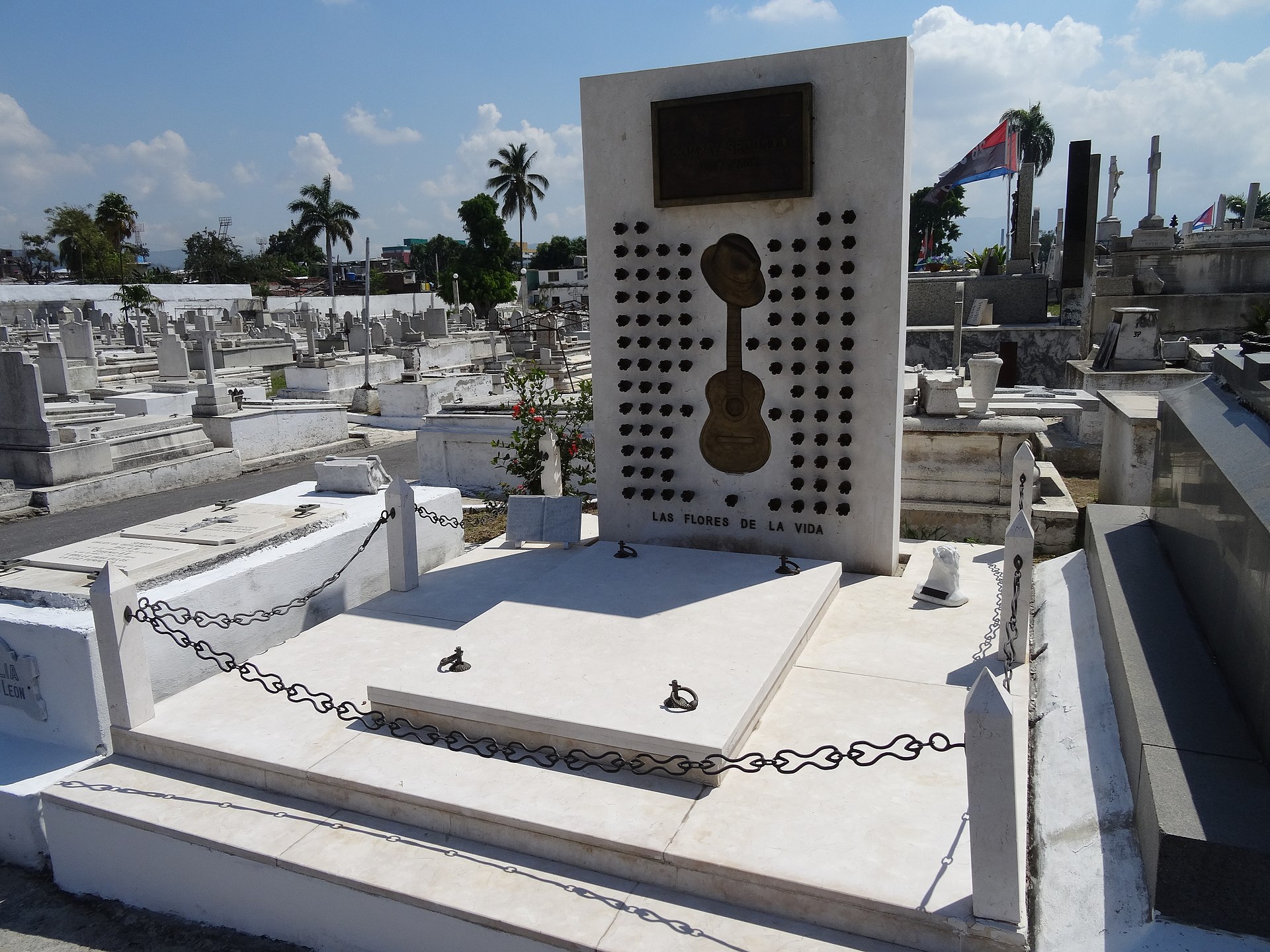 The tomb of Compay Segundo at the Cementerio de Santa Ifigenia in Santiago de Cuba. March 2014 In 2007, the 100th anniversary of Segundo's birth was celebrated with a concert of his compositions performed by a symphony orchestra in Havana with some of his musicians and sons.[4] https://en.wikipedia.org/wiki/Compay_Segundo |
コンパイ・セグンドこと、マキシモ・フランシスコ・レピラード・ムニョス・テレス(1907年11月18日-2003年7月13日)は、キューバのトローバ・ギタリスト、歌手、作曲家である。 略歴 コンパイ・セグンドは、音楽仲間では常に二番手だったことからそう呼ばれるようになった。彼の最初の仕事は、師であるエンリケ・ブエノが指揮するサンティ アゴ・デ・クーバ市立音楽団だった。1934年、クインテットで活動した後、ハバナに移り、市立音楽団のCIでクラリネットも演奏した。また、ギターとト レスも習得し、これらは彼の常用楽器となった。1950年代には、ロレンソ・ヒエレスエロと1947年に結成したデュオ、ロス・コンパドレスの第2声部と トレス奏者として知られるようになった[2]。 ロス・コンパドレスは、当時最も成功したキューバ人デュオのひとつであった。その後、1997年にブエナ・ビスタ・ソシアル・クラブのアルバムがリリースされ、グラミー賞を受賞した。コンパイ・セグンドは、ヴィム・ヴェンダースの同タイトルの映画に出演している[1]。 セグンドの最も有名な作曲は、アルバム『ブエナ・ビスタ・ソシアル・クラブ』のオープニング・トラックで、4和音のソン・クバーノの曲である 「Chan Chan 」である。「チャン・チャン」は、セグンド自身によって様々な形でレコーディングされたほか、数え切れないほど多くのラテン・アーティストによってレコー ディングされた。他にも 「Sarandonga」、「La calabaza」、「Hey caramba」、「Macusa」、「Saludo Compay 」などがある。これらはすべてソネであり、ボレロに傾倒する通常のトロバ・ミュージシャンとは一線を画している。しかし、彼の興味はもっと先にあったよう だ: 私はダンツォーネ、ワルツ、ソネを持っている。私はダンツォーネ、ワルツ、ソーンを持っている。なぜかって?音楽の伝統を守る方法を知っている人たちから 学んだからだ。私は昔演奏されていた方法で音楽を演奏している。最初はソン・コルト(短いソン)を弾いていた。ミゲル・マタモロスがよく言っていたよう に、「ソンは短くて甘い」...。その昔、彼らは夜の7時にソンを弾き始め、それで夜明けを迎えたんだ」[3]。 あるフィエスタで、彼はフィデル・カストロ大統領の前で歌い、カストロ大統領は彼の脈拍を測り、90歳を超えているにもかかわらず彼の生命力について冗談 を言った。バチカン市国でローマ法王ヨハネ・パウロ2世の前で「チャン・チャン」を演奏している自分に気づいたとき、彼は「誰が想像できただろう」と尋ね た。彼は自分の長寿を簡単に説明した。マトンのコンソメとラム酒だ。 彼は115歳まで生きると予言していたが、ハバナで腎不全のため志半ばで20年足らずの95歳の生涯を閉じた。  サンティアゴ・デ・クーバのセメンテリオ・デ・サンタ・イフィゲニアにあるコンパイ・セグンドの墓。2014年3月 2007年、セグンドの生誕100周年を記念して、ハバナで彼の音楽家や息子たちを交えた交響楽団によるセグンド作曲のコンサートが開催された[4]。 |
Trova [ˈtɾoβa] is a
style of Cuban popular music originating in the 19th century. Trova was
created by itinerant musicians known as trovadores who travelled around
Cuba's Oriente province, especially Santiago de Cuba, and earned their
living by singing and playing the guitar.[1] According to nueva trova
musician Noel Nicola, Cuban trovadors sang original songs or songs
written by contemporaries, accompanied themselves on guitar, and aimed
to feature music that had a poetic sensibility.[2] This definition fits
best the singers of boleros, and less well the Afrocubans singing funky
sones (El Guayabero) or even guaguancós and abakuá (Chicho Ibáñez). It
rules out, perhaps unfairly, singers who accompanied themselves on the
piano.[3] Casa de la Trova, Santiago de Cuba Trova musicians have played an important part in the evolution of Cuban popular music. Collectively, they have been prolific as composers, and have provided a start for many later musicians whose career lay in larger groupings. Socially, they reached every community in the country, and have helped to spread Cuban music throughout the world.[4] The founders Pepe Sánchez, born José Sánchez (Santiago de Cuba, 19 March 1856 – 3 January 1918), is known as the father of the trova style and the creator of the Cuban bolero.[5] He had some experience in bufo, but had no formal training in music. With remarkable natural talent, he composed numbers in his head and never wrote them down. As a result, most of these numbers are now lost forever, though some two dozen or so survive because friends and disciples wrote them down. His first bolero, Tristezas, is still remembered today. He also created advertisement jingles before the radio.[6] He was the model and teacher for the great trovadores who followed him.[7] The first, and one of the longest-lived, was Sindo Garay, born Antonio Gumersindo Garay Garcia (Santiago de Cuba, 12 April 1867 – Havana, 17 July 1968). He was the most outstanding composer of trova songs, and his best have been sung and recorded many times. Perla marina, Adiós a La Habana, Mujer bayamesa, El huracán y la palma, Guarina and many others are now part of Cuba's heritage. Garay was also musically illiterate – in fact, he only taught himself the alphabet at 16 – but in his case not only were scores recorded by others, but there are recordings as well. In the 1890s Garay got involved in the Cuban War of Independence, and decided a stay in Hispaniola (Haiti and Dominican Republic) would be a good idea. It was, and he came back with a wife. Garay settled in Havana in 1906, and in 1926 joined Rita Montaner and others to visit Paris, spending three months there singing his songs. He broadcast on radio, made recordings and survived into modern times. He used to say "Not many men have shaken hands with both José Martí and Fidel Castro!" Carlos Puebla, whose life spanned the old and the new trova, told a good joke about him: "Sindo celebrated his 100th birthday several times – in fact, whenever he was short of money!"[8][9]  The four greats of the trova from left: Rosendo Ruiz, Manuel Corona, Sindo Garay, Alberto Villalón José 'Chicho' Ibáñez (Corral Falso,[10] 22 November 1875 – Havana, 18 May 1981)[11] was the first trovador (that we know of) to specialize in the son and also on guaguancós and afrocuban rhythms from the abakuá. He played the tres rather than the Spanish guitar, and developed his own technique for this Cuban guitar. During his extremely long career, Chicho sang and played the son in streets, plazas, cafés, nightclubs and other venues throughout Cuba. In the 1920s, when the sextetos became popular, he was forced to sell his compositions to these larger groups and their composers in order to survive. His compositions include Toma, mamá, que te manda tía, Evaristo, No te metas Caridad, Ojalá (sones); Yo era dichoso, Al fin mujer (bolero-sones); Qué más me pides, La saya de Oyá (guaguancós). He worked throughout Cuba, and latterly a short film was made of him ('See also' below). The composer Rosendo Ruiz (Santiago de Cuba, 1 March 1885 – Havana, 1 January 1983) was a trovador almost as long-lived as Ibáñez and Garay. He wrote the criolla Mares y Arenas in 1911, the workers' anthem Redención in 1917, the bolero Confesión, the guajira Junto al cañaveral and the pregón-son Se va el dulcerito. He was the author of a well-known guitar manual. Manuel Corona (Caibarién, 17 June 1880 – Havana 9 January 1950) started his career in a red-light district of Havana. Originally a singer-guitarist, he became a prolific composer after his hand was damaged by a pimp's knife. It was a case of "She was a whore, and she had her man, but I loved her". Alberto Villalón (Santiago de Cuba, 7 June 1882 – Havana 16 07 1955) advanced the trova guitar technique and had a hand in the birth of the son septetos. Garay, Ruiz, Villalón and Corona were known as the four greats of the trova, but Ibáñez and the following trovadores should be regarded as of equally high stature. The 20th century Patricio Ballagas (Camagüey, 17 March 1879 – Havana, 15 February 1920); Eusebio Delfín (Palmira, 1 April 1893 – Havana, 28 April 1965); María Teresa Vera (Guanajay, 6 February 1895 – Havana, 17 December 1965); Lorenzo Hierrezuelo (El Caney, 5 September 1907 – Havana, 16 November 1993); Joseíto Fernández (September 5, 1908 – October 11, 1979); Ñico Saquito (Antonio Fernandez: Santiago de Cuba, 1901 – Havana, 4 August 1982); Carlos Puebla (Manzanillo, 11 September 1917 – Havana, 12 July 1989) and Compay Segundo (Máximo Francisco Repilado Muñoz: Siboney, 18 November 1907 – Havana, 13 July 2003) were all great trova musicians. And let's not forget the Trío Matamoros, who worked together for most of their lives. Matamoros was one of the greats.[12] Most trovadors were creolized, drawing from both Spanish and African traditions and styles even-handedly. There were exceptions. Guillermo Portabales (Cienfuegos, 6 April 1911 – San Juan, Puerto Rico 25 October 1970) and Carlos Puebla were mostly in the guajiro (peasant) tradition, whilst El Guayabero – Faustino Oramas – (Holguín, 4 June 1911 – Holguín, 28 March 2007) was black and funky in style and content. He was the last of the old trova, the oldest working musician in Cuba, at 95, when he died. His double entendres were a joy. 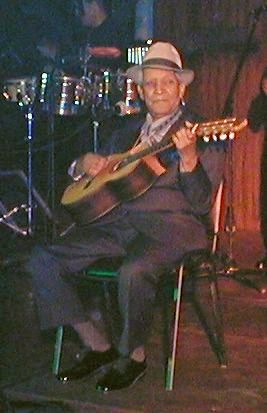 Compay Segundo at the Hotel Nacional de Cuba Trova musicians often worked in pairs and trios, some of them exclusively solo (Compay Segundo). As the sextetos / septetos / conjuntos grew in popularity many trovadores joined in the larger groups. The technique of guitar-playing gradually improved; the early trovadors, being self-taught, had rather limited techniques. Later, some tapped into classical guitar techniques to revive the accompaniment of the trova. Guyún (Vincente Gonzalez Rubiera, Santiago de Cuba, 27 October 1908–Havana, 1987) studied under Severino López, and developed a modern concept of harmony, and a way to apply classical technique to popular Cuban music. He became more adventurous, yet still in Cuban vein, and in 1938 stopped performing to devote himself to teaching the guitar. This bore fruit, and two generations of Cuban guitarists bear witness to his influence. Perhaps the greatest guitarist amongst modern Cuban trovadors is Eliades Ochoa (b. Songo – La Maya, Santiago de Cuba, 22 June 1946), the leader of Cuarteto Patria. Ochoa learnt both Spanish guitar and the Cuban trés; Cuban composer and classical guitarist Leo Brouwer told him that he did not need to learn more about musical technique as he already knew too much! Ochoa plays now with an eight-stringed guitar (a self-designed hybrid of an acoustic six-string and the Cuban trés). Cuerteto Patría includes his brother Humberto Ochoa on guitar, son Eglis Ochoa on maracas, William Calderón on bass, Aníbal Ávila on claves and trumpet, and Roberto Torres on congas. Offshoots of the trova The trova movement has given rise to offshoots which have grown in the fertile musical earth of Cuba and other Latin-American countries. The following are elements in the trova's great influence: 1. The huge number of lyric compositions which have been used in all areas of Latin-American popular music. 2. Unforgettable musical compositions which became latin standards. 3. The bolero, the musical form most closely associated with the trova, and its relative the canción. 4. The development of guitar technique in popular music. 5. Themes and initiatives related to politico-social events, such as Afrocubanismo, Filín (feeling), and Nueva trova. Filin Main article: Filin The word is derived from feeling; it was a US–influenced popular musical fashion of the late 40s and the 50s. It describes a style of post-microphone jazz-influenced romantic song (crooning).[13] Its Cuban roots were in the bolero and the canción. Some Cuban quartets, such as Cuarteto d'Aida and Los Zafiros, modelled themselves on U.S. close-harmony groups. Others were singers who had heard Ella Fitzgerald, Sarah Vaughan and Nat King Cole. Filín singers included César Portillo de la Luz, José Antonio Méndez, who spent a decade in Mexico from 1949 to 1959, Frank Domínguez, the blind pianist Frank Emilio Flynn, and the great singers of boleros Elena Burke and the still-performing Omara Portuondo, who both came from the Cuarteto d'Aida. The filín movement, which originally had a place every afternoon on Radio Mil Diez, survived the first few years of the revolution quite well, but somehow did not suit the new circumstances and gradually withered, leaving its roots in jazz, romantic song and the bolero perfectly healthy. Some of its most prominent singers, such as Pablo Milanés, took up the banner of the nueva trova. Nueva trova Main article: Nueva trova The Cuban Nueva trova dates from the 1967/68, after the Cuban Revolution of 1959, and the consequent political and social changes. It differed from the traditional trova, not because the musicians were younger, but because the content was, in the widest sense, political. Nueva trova is defined, not only by its connection with Castro's revolution, but also by its lyrics. The lyrics attempt to escape the banalities of life (e.g. love) by concentrating on socialism, injustice, sexism, colonialism, racism and similar 'serious' issues.[14] Silvio Rodríguez and Pablo Milanés became the most important exponents of this style. Carlos Puebla and Joseíto Fernández were long-time trova singers who added their weight to the new regime, but of the two only Puebla wrote special pro-revolution songs.[15] The regime gave plenty of support to musicians willing to write and sing anti-U.S. or pro-revolution songs; this was quite a bonus in an era when many of the traditional musicians were finding it difficult or impossible to earn a living. In 1967 the Casa de las Américas in Havana held a Festival de la canción de protesta (protest songs). Much of the effort was spent applauding causes that would annoy the U.S. government. Tania Castellanos, a filín singer and author, wrote ¡Por Angela! in support of Angela Davis. César Portillo de la Luz wrote Oh, valeroso Viet Nam.[16] These were hot topics of the 1970s, but their topicality declined as time passed. Nueva Trova, initially so popular, was dealt a blow by the fall of the Soviet Union, though it was already fading. It suffered inside Cuba, perhaps from a growing disenchantment with one-party rule, and externally, from the vivid contrast with the Buena Vista Social Club film and recordings. Audiences round the world have had their eyes opened to the extraordinary charm and musical quality of the older forms of Cuban music. By contrast, topical themes that seemed so relevant in the 1960s and 70s now seem dry and passé; once a theme is no longer topical, the piece rests solely on its musical quality. Those pieces of high musical and lyrical quality, amongst which Puebla's Hasta siempre stands out, will probably last as long as Cuba lasts.[17][18] Other notables The musicians featured here are a few notables amongst hundreds of excellent musicians living the same kind of life. No complete list exists, though the musicians listed below have been mentioned in at least one source.[19] After the name, one or two of their best compositions are noted: Salvador Adams ("Me causa celos") Ángel Almenares ("Por qué me engañaste?") José (Pepe) Banderas ("Boca roja") Emiliano Blez Garbey ("Besada por el mar") Julio Brito ("Flor de ausencia") Miguel Companioni ("Mujer perjura") Juan de Dios Hechavarria ("Mujer indigna", "Tiene Bayamo", "Laura") José (Pepe) Figarola Salazar ("Un beso en le alma") Graciano Gómez Vargas ("En falso", "Yo sé de esa mujer") Rafael Gómez (aka Teofilito) ("Pensamiento") Oscar Hernández Falcón ("Ella y yo", "La Rosa roja") Ramón Ivonet ("Levanta") Eulalio Limonta Manuel Luna Salgado ("La cleptómana") Nené Manfugás Rafael Saroza Valdés ("Guitarra mía") Duos, trios, groups During a career, a musician may work in many different line-ups. Because of the limited sonority of the guitar, trova musicians preferred small groups, or solo performances. Boleros tend to benefit from two voices, primo and segundo, giving to melodic phrases a richness in contrast with the basic rhythm of the cinquillo.[20] Duos Guaronex y Sindo: Sindo Garay and his son. Floro y Miguel: Floro Zorilla and Miguel Zaballa. Outstanding in their day. Floro y Cruz: Floro Zorilla and Juan Cruz. Cruz was a terrific baritone. Pancho Majagua y Tata Villegas: Francisco Salvo and Carlos Villegas. María Teresa y Zequieira: María Teresa Vera and Rafael Zequeira. Dúo Ana María y María Teresa: two female voices, Ana María García and Ma. Teresa Vera. Justa García also sang duo with each of these two women. Lorenzo Hierrezuelo and María Teresa Vera. José 'Galleguito' Parapar y Higinio Rodríguez. Juan de la Cruz y Bienvenido León. Manuel Luna y José Castillo. Dúo Hermanos Enriso: Enrique 'Chungo' and Rafael 'Nené' Enriso. Dúo Luna–Armiñan: Pablo Armiñan (primo) and Manuel Luna (segundo and guitar) Dúo Pablito–Castillo: Pablo Armiñan (primo) and Augusto Castillo (segundo). Dúo Pablito y Limonta: Pablo Armiñan (voz primo and guitar accompanist) and Juan Limonta (segunda, guitar and author). Extremely popular in Santiago de Cuba in the 1920s. Dúo Juanito Valdés y Rafael Enriso. Dúo Carbo–Quevedo: Pablo Quevedo (primo) and Panchito Carbó (segundo and guitar). Dúo Hermanas Martí: Amelia and Bertha. Dúo Sirique y Miguel: Alfredo 'Sirique' González and Miguel Doyble. Los Compadres: Lorenzo Hierrezuelo, first with Compay Segundo, then with Rey Caney. Trios Trio Palabras: Vania Martinez, Liane Pérez, Nubia González. See also 1977 Del hondo del corazón. 20min film, Dir. Constante Diego. Figures of the traditional trova talk and sing. 1974 Chicho Ibáñez. 11min film, Dir. Juan Carlos Tabío. Short film on the trovador José 'Chicho' Ibáñez (1875–1981), who talks and sings at the age of 99. https://en.wikipedia.org/wiki/Trova |
トロバ[ˈtɾoβa]は、19世紀に生まれたキューバのポピュラー音
楽のスタイルである。トロバは、キューバのオリエンテ州、特にサンティアゴ・デ・クーバを旅し、歌とギターの演奏で生計を立てていたトロバドールと呼ばれ
る旅人音楽家たちによって創始された。 [1]
ヌエバ・トロバ・ミュージシャンのノエル・ニコラによれば、キューバのトロバドールはオリジナル曲や同時代のミュージシャンが書いた曲を歌い、ギターで伴
奏をつけ、詩的な感性を持った音楽を特徴とすることを目指した[2]。この定義は、ボレロスを歌うシンガーに最もよく当てはまり、ファンキーなソン(エ
ル・グアヤベーロ)やグアガンコスやアバクア(チチョ・イバニェス)を歌うアフロキューバ人にはあまり当てはまらない。おそらく不公平なことに、ピアノ伴
奏をする歌手は除外されている[3]。 カサ・デ・ラ・トロバ、サンティアゴ・デ・クーバ トロバの音楽家たちは、キューバのポピュラー音楽の発展において重要な役割を果たしてきた。集団として、彼らは作曲家として多作であり、より大きなグルー プでキャリアを積んだ多くの後進の音楽家に出発点を提供した。社会的にも、彼らはキューバのあらゆるコミュニティに働きかけ、キューバ音楽を世界中に広め ることに貢献した[4]。 創設者たち ホセ・サンチェス(José Sánchez、サンティアゴ・デ・クーバ、1856年3月19日~1918年1月3日)生まれのペペ・サンチェスは、トロバ・スタイルの父、キューバの ボレロの創始者として知られている[5]。驚くべき天賦の才能を持つ彼は、頭の中でナンバーを作曲し、それを書き留めることはなかった。その結果、これら のナンバーのほとんどは永久に失われてしまったが、20数曲は友人や弟子たちが書き留めたために残っている。彼の最初のボレロ『トリステーザス』は、今日 でも記憶に残っている。彼はまた、ラジオ以前の広告ジングルも創作した[6]。彼は、彼に続く偉大なトロヴァドールたちの手本であり、師であった[7]。 最初の、そして最も長生きした一人は、アントニオ・グメルシンド・ガルシア(Antonio Gumersindo Garay Garcia、サンティアゴ・デ・クーバ、1867年4月12日 - ハバナ、1968年7月17日)生まれのシンド・ガライ(Sindo Garay)である。彼はトロバの歌の最も優れた作曲家であり、彼の最高傑作は何度も歌われ、録音されている。Perla marina、Adiós a La Habana、Mujer bayamesa、El huracán y la palma、Guarina、その他多くの曲は、今やキューバの遺産の一部となっている。ガレイは音楽的な文盲でもあった。実際、彼は16歳の時にアル ファベットを独学で学んだだけだったが、彼の場合、楽譜が他の人によって録音されただけでなく、レコーディングも存在する。 1890年代、ガレイはキューバ独立戦争に巻き込まれ、イスパニョーラ(ハイチとドミニカ共和国)に滞在することを決めた。そうして彼は妻を連れて帰国し た。ガレイは1906年にハバナに定住し、1926年にはリタ・モンタネールらとパリを訪れ、そこで3ヶ月間自分の歌を歌った。彼はラジオで放送し、レ コーディングを行い、現代まで生き残った。彼はよく 「ホセ・マルティとフィデル・カストロの両方と握手した男はそうそういない!」と言っていた。カルロス・プエブラは、新旧のトロバにまたがる人生を送った が、彼についてジョークを言った: 「シンドは何度も100歳の誕生日を祝った。実際、お金がないときはいつでも!」[8][9]。  トロヴァの4人の偉人 左から ロセンド・ルイス、マヌエル・コロナ、シンド・ガライ、アルベルト・ビジャロン ホセ・'チチョ'・イバニェス(コラル・ファルソ、1875年11月22日-ハバナ、1981年5月18日)[11]は、ソンを専門とし、グアガンコーや アバクアのアフロキューバのリズムも演奏した最初のトロバドールである。彼はスパニッシュ・ギターではなくトレスを弾き、このキューバ産ギターのために独 自のテクニックを開発した。非常に長いキャリアの間、チチョはキューバ中の路上、広場、カフェ、ナイトクラブなどで歌い、演奏した。1920年代、六重奏 団が人気を博すようになると、彼は生き残るために、自分の作曲した曲をこのような大きなグループやその作曲家たちに売り込むことを余儀なくされた。彼の作 曲した曲には、Toma, mamá, que te manda tía, Evaristo, No te metas Caridad, Ojalá(歌)、Yo era dichoso, Al fin mujer(ボレロ歌)、Qué más me pides, La saya de Oyá(グアガン歌)などがある。キューバ全土で活動し、後に短編映画も制作された(下記参照)。 作曲家ロセンド・ルイス(サンティアゴ・デ・クーバ、1885年3月1日-ハバナ、1983年1月1日)は、イバニェスやガライと同じくらい長命なトロバ ドールである。1911年にクリオラの「Mares y Arenas」、1917年に労働者賛歌「Redención」、ボレロの「Confesión」、グアヒーラの「Junto al cañaveral」、プレゴンの「Se va el dulcerito」を作曲した。有名なギター教則本の著者でもある。 マヌエル・コロナ(1880年6月17日カイバリェン - 1950年1月9日ハバナ)は、ハバナの歓楽街でキャリアをスタートさせた。元々はシンガー・ギタリストだったが、ポン引きのナイフで手を傷つけられた 後、多作な作曲家となった。彼女は売春婦で男もいたが、私は彼女を愛していた」というケースだった。アルベルト・ビジャロン(サンティアゴ・デ・クーバ、 1882年6月7日 - ハバナ、1955年7月16日)は、トロバ・ギターのテクニックを発展させ、息子セプテットの誕生に貢献した。 ガレイ、ルイス、ビジャロン、コロナがトロバの4大巨頭として知られているが、イバニェスやそれに続くトロバドールも同様に高い評価を受けるべきだろう。 20世紀 パトリシオ・バラガス(カマグエイ、1879年3月17日~ハバナ、1920年2月15日)、エウセビオ・デルフィン(パルミラ、1893年4月1日~ハ バナ、1965年4月28日)、マリア・テレサ・ベラ(グアナハイ、1895年2月6日~ハバナ、1965年12月17日)、ロレンソ・ヒエレスエロ(エ ル・カネイ、1907年9月5日~ハバナ、1993年11月16日)、ホセイト・フェルナンデス(1908年9月5日~1979年10月11日)、ニコ・ サキート(アントニオ・フェルナンデス: カルロス・プエブラ(マンサニージョ、1917年9月11日-ハバナ、1989年7月12日)、コンパイ・セグンド(マキシモ・フランシスコ・レピラー ド・ムニョス:シボニー、1907年11月18日-ハバナ、2003年7月13日)は、いずれも偉大なトロバ・ミュージシャンだった。そして、生涯の大半 を共にしたトリオ・マタモロスも忘れてはならない。マタモロスは偉大な人物の一人だった[12]。 ほとんどのトロバドールはクレオール化しており、スペインとアフリカの両方の伝統とスタイルを均等に取り入れていた。例外もあった。ギジェルモ・ポルタバ レス(Guillermo Portabales, Cienfuegos, 6 April 1911 - San Juan, Puerto Rico, 25 October 1970)とカルロス・プエブラ(Carlos Puebla)はグアヒーロ(農民)の伝統を受け継ぎ、エル・グアヤベーロ(El Guayabero - Faustino Oramas, Holguín, 4 June 1911 - Holguín, 28 March 2007)はスタイルも内容もブラックでファンキーだった。95歳で亡くなった彼は、キューバで最も高齢の現役ミュージシャン、オールド・トロバの最後の 一人だった。彼の二枚舌は楽しいものだった。  コンパイ・セグンド ホテル・ナシオナル・デ・クーバにて トロバの音楽家たちは、しばしば2人1組や3人組で活動したが、中にはもっぱらソロで活動する者もいた(コンパイ・セグンド)。六重奏/七重奏/コンフン トの人気が高まるにつれ、多くのトロヴァドールが大きなグループに加わった。 ギター演奏のテクニックは徐々に向上していったが、初期のトロヴァドールは独学だったため、テクニックはかなり限られていた。その後、クラシック・ギター のテクニックを取り入れて、トロヴァの伴奏を復活させた者もいる。グユン(Vincente Gonzalez Rubiera、サンティアゴ・デ・クーバ、1908年10月27日-ハバナ、1987年)は、セヴェリーノ・ロペスに師事し、和声の現代的な概念と、ポ ピュラーなキューバ音楽にクラシックのテクニックを応用する方法を開発した。1938年、ギターの指導に専念するため、演奏活動を休止した。これが実を結 び、2世代のキューバ人ギタリストが彼の影響を証明している。 現代のキューバ人ギタリストの中で最も偉大なのは、クアルテート・パトリアのリーダー、エリアデス・オチョア(1946年6月22日、サンティアゴ・デ・ クーバ、ソンゴ・ラ・マヤ生まれ)だろう。オチョアはスパニッシュ・ギターとキューバン・トレの両方を学んだ。キューバの作曲家でクラシック・ギタリスト のレオ・ブローウェルは彼に、音楽的テクニックについてはすでに知りすぎているので、これ以上学ぶ必要はないと言った!オチョアは現在、8弦ギター(ア コースティック6弦とキューバン・トレのハイブリッド)を使って演奏している。クエルテート・パトリアには、兄のウンベルト・オチョアがギター、息子のエ グリス・オチョアがマラカス、ウィリアム・カルデロンがベース、アニバル・アビラがクラベス、トランペット、ロベルト・トーレスがコンガで参加している。 トローバの分派 トローバ・ムーブメントは、キューバをはじめとするラテンアメリカ諸国の肥沃な音楽の大地で育った分派を生み出した。以下は、トローバが大きな影響力を持 つ要素である: 1. 1.ラテンアメリカのポピュラー音楽のあらゆる分野で使用されてきた膨大な数の抒情的楽曲。 2. ラテン・スタンダードとなった忘れがたい楽曲。 3. 3.ボレロは、トローバと最も密接に結びついた音楽形式であり、カンシオンはその親戚である。 4. ポピュラー音楽におけるギター奏法の発展 5. アフロキューバニスモ、フィリン(フィーリング)、ヌエバ・トロバなど、政治的・社会的出来事に関連したテーマと取り組み。 フィリン 主な記事 フィリン フィーリングから派生した言葉で、40年代後半から50年代にかけて米国の影響を受けたポピュラー音楽の流行である。マイクロフォン後のジャズの影響を受 けたロマンティックな歌(クルーニング)のスタイルを表す[13]。キューバのルーツはボレロとカンシオンである。クアルテート・ダイーダやロス・ザフィ ロスといったキューバのカルテットは、アメリカのクローズ・ハーモニー・グループを手本にしていた。また、エラ・フィッツジェラルドやサラ・ヴォーン、 ナット・キング・コールを聴いたことのある歌手もいた。フィリンの歌手には、セザール・ポルティージョ・デ・ラ・ルス、1949年から1959年までの 10年間をメキシコで過ごしたホセ・アントニオ・メンデス、フランク・ドミンゲス、盲目のピアニスト、フランク・エミリオ・フリン、ボレロスの大歌手エレ ナ・バークと現在も演奏活動を続けるオマーラ・ポルトゥオンドがいた。 もともとラジオ・ミル・ディエスで毎日午後に放送されていたフィリン・ムーブメントは、革命の最初の数年間はよく生き延びたが、どういうわけか新しい状況 には合わず、ジャズ、ロマンティック・ソング、ボレロのルーツは完全に健全なまま、次第に枯れていった。パブロ・ミラネスのような最も著名な歌手の何人か は、ヌエバ・トロバの旗を掲げた。 ヌエバ・トロバ 主な記事 ヌエバ・トロバ キューバのヌエバ・トロバは、1959年のキューバ革命とそれに伴う政治的・社会的変化の後、1967年から68年にかけて生まれた。伝統的なトローバと 異なるのは、音楽家が若かったからではなく、その内容が広い意味で政治的だったからである。ヌエバ・トロバは、カストロ革命との関連だけでなく、その歌詞 によっても定義される。歌詞は、社会主義、不正義、性差別、植民地主義、人種差別、そして同様の「深刻な」問題に集中することで、人生の平凡さ(例えば恋 愛)から逃れようとする。カルロス・プエブラとホセイト・フェルナンデスは、新体制に重きを置いた長年のトローバ歌手だったが、2人のうちプエブラだけが 特別に親革命的な曲を書いた[15]。 多くの伝統的な音楽家が生計を立てることが困難か不可能であった時代には、これは非常に喜ばしいことであった。1967年、ハバナのカサ・デ・ラス・アメ リカスは、プロテスト・ソング・フェスティバルを開催した。その努力の多くは、アメリカ政府を困らせるような大義名分に拍手を送ることに費やされた。フィ リピン人歌手であり作家でもあるタニア・カステジャーノスは、アンジェラ・デイヴィスを支持して『アンジェラのために!』を書いた。セサル・ポルティー ジョ・デ・ラ・ルスは『ああ、ヴェトナム』を書いた[16]。これらは1970年代のホットなトピックだったが、時が経つにつれて話題性は薄れていった。 ヌエバ・トローバは、当初は非常に人気があったが、ソビエト連邦の崩壊によって打撃を受けた。キューバ国内では、おそらく一党支配への幻滅の高まりから、 また対外的には、ブエナ・ビスタ・ソシアル・クラブの映画やレコーディングとの鮮やかなコントラストから、苦境に立たされた。世界中の聴衆は、キューバ音 楽の古い形式が持つ並外れた魅力と音楽的な質に目を見開かされた。それとは対照的に、1960年代や70年代にはとても適切だと思われた話題性のあるテー マは、今では乾いて古臭く感じられる。プエブラの「Hasta siempre」が傑出しているように、高い音楽性と叙情性を備えた作品は、おそらくキューバが存続する限り続くだろう[17][18]。 その他の著名人 ここで取り上げたミュージシャンは、同じような生活を送っている何百人もの優れたミュージシャンの中の数少ない著名人である。完全なリストは存在しない が、以下に挙げる音楽家は少なくとも1つの情報源で言及されている[19]。 名前の後に、彼らの最も優れた作曲の1つか2つが記されている: サルバドール・アダムス(「Me causa celos) アンヘル・アルメナーレス(「Por qué me engañaste?) ホセ(ペペ)・バンデラス(「Boca roja」) エミリアーノ・ブレス・ガルベイ("Besada por el mar) フリオ・ブリトー(「オーセンシアの花) ミゲル・コンパニオニ("Mujer perjura) フアン・デ・ディオス・ヘチャバリア(「Mujer indigna」、「Tiene Bayamo」、「Laura」) ホセ(ペペ)・フィガロラ・サラサール(「Un beso en le alma」) グラシアーノ・ゴメス・バルガス(「En falso」、「Yo sé de esa mujer」) ラファエル・ゴメス(別名テオフィリート)("ペンサミエント) オスカル・エルナンデス・ファルコン(「Ella y yo」、「La Rosa roja) ラモン・イボネット(『レバンタ) エウラリオ・リモンタ マヌエル・ルナ・サルガド(「ラ・クレプトマナ) ネネ・マンフガス ラファエル・サロサ・バルデス(「Guitarra mía) デュオ、トリオ、グループ ミュージシャンはキャリアの中で、さまざまな編成で活動することがある。ギターの音域は限られているため、トローバの音楽家は小編成のグループやソロ演奏 を好んだ。ボレロは、プリモとセグンドの2声部がメロディックなフレーズに豊かさを与え、チンキージョの基本的なリズムとは対照的である[20]。 デュオ グアロネックスとシンド シンド・ガライとその息子。 フロロ・イ・ミゲル:フロロ・ゾリージャとミゲル・サバラ。当時は傑出した存在だった。 フロロ・イ・クルス フロロ・ゾリージャとフアン・クルス。クルスは素晴らしいバリトンだった。 パンチョ・マジャグアとタタ・ビジェガス: フランシスコ・サルボとカルロス・ビジェガス。 マリア・テレサ・イ・ゼケイラ:マリア・テレサ・ベラとラファエル・ゼケイラ。 ドゥオ・アナ・マリア・イ・マリア・テレサ:2人の女声、アナ・マリア・ガルシアとMa. Teresa Veraである。フスタ・ガルシアもこの2人の女性とデュオを組んだ。 ロレンソ・ヒエレスエロとマリア・テレサ・ベラ。 ホセ'ガレギート'パラパルとヒギニオ・ロドリゲス。 フアン・デ・ラ・クルスとビエンベニド・レオン。 マヌエル・ルナとホセ・カスティーリョ ドゥオ・エルマノス・エンリソ エンリケ'チュンゴ'とラファエル'ネネ'エンリソ。 ドゥオ・ルナ・アルミニャン パブロ・アルミニャン(プリモ)とマヌエル・ルナ(セグンドとギター) ドゥオ・パブリート=カスティーリョ:パブロ・アルミーニャン(プリモ)とアウグスト・カスティーリョ(セグンド) ドゥオ・パブリート・イ・リモンタ パブロ・アルミーニャン(プリモ、ギター伴奏)とフアン・リモンタ(セグンダ、ギター、作家)。1920年代にサンティアゴ・デ・クーバで絶大な人気を 誇った。 ドゥオ・フアニト・バルデスとラファエル・エンリソ。 ドゥオ・カルボ=ケベド:パブロ・ケベド(プリモ)とパンチート・カルボ(セグンド、ギター)。 ドゥオ・エルマナス・マルティ アメリアとベルサ。 ドゥオ・シリケ・イ・ミゲル:アルフレド'シリケ'ゴンサレスとミゲル・ドイブル。 ロス・コンパドレス ロレンソ・ヒエレスエロ、最初はコンパイ・セグンドと、その後レイ・カネイと。 トリオ トリオ・パラブラス: バニア・マルティネス、リアン・ペレス、ヌビア・ゴンサレス。 以下も参照のこと。 1977年 心臓の鼓動。20分映画、監督:コンスタンテ・ディエゴ。コンスタンテ・ディエゴ監督。伝統的なトローバの人々が語り、歌う。 1974年 チチョ・イバニェス。11分の映画、監督:フアン・カルロス・タビオ。フアン・カルロス・タビオ監督。99歳にして語り、歌うトロバドール、ホセ・'チ チョ'・イバニェス(1875-1981)の短編映画。 |
リ ンク
文 献
そ の他の情報
Copyleft, CC, Mitzub'ixi Quq Chi'j, 1996-2099
☆
 ☆
☆